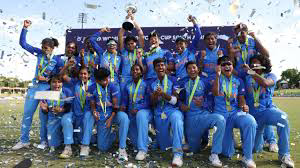Indian women cricket team history:-
The Indian women's cricket team has a rich history. They played their first Test match in 1976 against the West Indies. Over the years, the team has participated in multiple World Cups and has seen significant growth in performance. Notable players like Mithali Raj and Jhulan Goswami have made substantial contributions, and the team continues to make strides in international cricket, showcasing skill and determination.
Awards and medals women's cricket team:-
The Indian women's cricket team and its players have received various awards and accolades for their achievements. Some notable recognitions include:
Arjuna Award:
Several players from the women's cricket team, such as Mithali Raj, Jhulan Goswami, Harmanpreet Kaur, and Smriti Mandhana, have been honored with the prestigious Arjuna Award for their outstanding contributions to cricket.
Padma Shri:
Mithali Raj, the former captain of the Indian women's cricket team, has been awarded the Padma Shri, one of India's highest civilian honors, in recognition of her accomplishments in cricket.
Rajiv Gandhi Khel Ratna:
Cricketer Smriti Mandhana received the Rajiv Gandhi Khel Ratna, India's highest sporting honor, for her stellar performances in international cricket.
These awards highlight the individual achievements of players, acknowledging their skill, dedication, and impact on women's cricket in India. The team as a whole also garners recognition for its collective efforts in various tournaments.
First cricketer women cricket team:-
The first woman cricketer to represent India in international cricket was Shanta Rangaswamy. She played for the Indian women's cricket team in the 1970s and was a pioneer in women's cricket in the country. Rangaswamy was a key figure in laying the foundation for women's cricket in India and played a crucial role in promoting the sport among women. Her contributions to the game have left a lasting impact on the development of women's cricket in India.
First woman cricket team captain:-
The first woman to captain the Indian women's cricket team was Shantha Rangaswamy. She led the team in its early days during the 1970s. Shantha Rangaswamy played a vital role not only as a player but also as a captain, contributing significantly to the growth and development of women's cricket in India. Her leadership set the stage for future captains and the team's progress in international cricket.
Now captain female cricket team:-
The captaincy of the Indian women's cricket team may have changed. At that time, Mithali Raj was leading the team in One Day Internationals (ODIs), while Harmanpreet Kaur was the captain for Twenty20 Internationals (T20Is). Please note that team captaincies can change, so I recommend checking the latest sources for the current captain of the Indian women's cricket team.
Most popular in women's cricket members:-
Determining the "most popular" members of the Indian women's cricket team can be subjective and may change over time. However, as of my last knowledge update in January 2022, a few players have gained significant popularity for their outstanding performances:
Mithali Raj:
Renowned for her leadership and batting prowess, Mithali Raj is considered one of the greatest cricketers in women's cricket history. She has been a consistent performer and the captain of the Indian women's cricket team.
Smriti Mandhana:
Smriti Mandhana is known for her aggressive batting style and has garnered attention for her performances in both domestic and international cricket. She is considered one of the rising stars of women's cricket.
Jhulan Goswami:
Jhulan Goswami is a pace-bowling legend in women's cricket. Her contributions to the Indian team as a fast bowler have made her a respected figure in the cricketing world.
Harmanpreet Kaur:
Harmanpreet Kaur is known for her explosive batting and has played crucial roles in many important matches for the Indian team. She also served as the captain for the T20I format.
These players have not only excelled on the field but have also played key roles in popularizing women's cricket in India. Keep in mind that popularity can vary, and newer players may have gained prominence since my last update.
History status in women's cricket team winning performance:-
The Indian women's cricket team has had a notable history of achievements and winning performances in international cricket. Here are some key highlights:
1978 - First Test Win:
India achieved its first-ever Test victory in women's cricket in 1978 against the West Indies under the captaincy of Shantha Rangaswamy.
2005 - Women's World Cup Final:
India reached the final of the ICC Women's World Cup in 2005 but narrowly missed the title, finishing as the runners-up.
2017 - Women's World Cup Final:
India had a remarkable run in the 2017 ICC Women's World Cup, reaching the final at Lord's. They faced England in a thrilling match but fell short, finishing as runners-up once again.
2018 - Asia Cup Triumph:
The Indian women's cricket team won the Asia Cup in 2018, displaying dominance in the subcontinent.
2020 - T20 World Cup Final:
India reached the final of the ICC Women's T20 World Cup in 2020 but couldn't secure the title, finishing as runners-up.
No
These achievements showcase the progress and competitiveness of the Indian women's cricket team on the global stage. The players have consistently demonstrated skill and determination, contributing to the growth of women's cricket in India.







Comments
Post a Comment